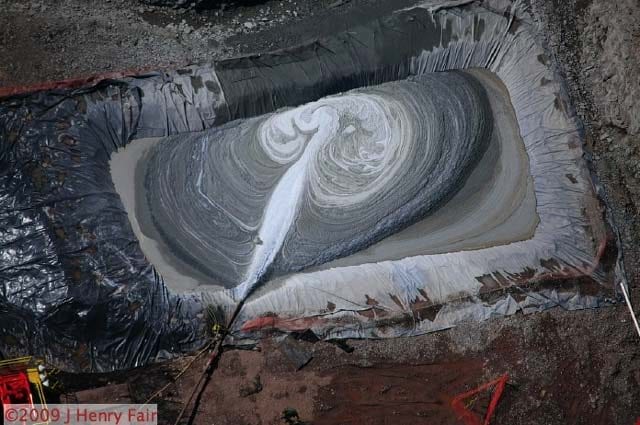
October 5, 2013. Blacklick Creek, PA. A just released study says that the oil and gas drilling method known as fracking is contaminating rivers and streams with radioactive waste. First it was the toxic chemicals. Then it was methane. Now, radium was found contaminating the waterways near a Pennsylvania fracking disposal site.
Energy companies continuously challenge local residents to prove that the oil and gas giants are putting the contaminants into the country’s drinking water. But outraged and fearful Americans insist they don’t care how the toxic, flammable and radioactive elements got in the water. They want it stopped, now.
Radioactive rivers
As detailed by Yahoo News and Live Science, a just released report published in the journal Environmental Science and Technology reveals that riverbed samples taken downstream from the Blacklick Creek, Pennsylvania site used to decontaminate fracking wastewater tested 200-times higher for the radioactive element radium than samples taken upstream from the facility.
Radium is a radioactive metal found naturally in rocks and other soil. Long-term exposure to it can cause a number of illnesses and diseases including leukemia. Avner Vengosh, from Duke University and a co-author of the report, said that some of the radium levels found outside the site were so high, they surpassed the levels found in actual radioactive waste dumps.
While the Josephine Brine Treatment Facility is in business to remove radium and other deadly contaminants from fracking wastewater, the scientists say it still accumulates at the bottom in the water’s seabed in the soil, sand and rocks. The scientists warned that the radioactive contamination will eventually make its way into the human food supply as insects and fish are contaminated and then eaten by larger animals.
Shocking findings
For two years, researchers monitored the Blacklick Creek fracking treatment facility prior to releasing their results. They not only tested the water and soil upstream and downstream from the site, they also tested the wastewater being discharged by the fracking operation into the surrounding environment. What they found was staggering.
One of the most eye-opening findings was the fact that the salinity level – or the amount of salt in the water – was 200-times the legal limit as mandated by the Clean Water Act. By comparison, the fresh river water that would normally have almost no salt actually contained 10-times more salt than the world’s salt water oceans. Environmentalists are outraged because, as Duke’s Avner Vengosh put it, fracking operations are exempt from the clean water laws.
William Schlesinger, a researcher and president of the Cary Institute of Ecosystem Studies in Millbrook, NY told Live Science that this report was proof that fracking is contaminating rivers and streams. Apparently, the measurements of substances like radium and bromide match the levels from the Marcellus Shale Formation like a fingerprint.
The drilling companies use water and chemicals to free the specs of oil and gas from the rock by fracturing it. Once the water is contaminated, it is sent to places like the Josephine Brine Treatment Facility. There, the water is allegedly decontaminated and either released back into the environment or delivered back to the drilling companies for reuse.
Above the law
As the Duke University researcher reminded us, the fracking companies are exempt from many clean water laws. But even if they weren’t, there’s evidence to show that nothing would be done to stop the ongoing contamination anyway. Mark Schlosberg from Food and Water Watch just happened to be in the middle of a campaign to raise awareness of the EPA’s continuing practice of halting investigations into fracking contamination of waterways.
“In recent weeks, EPA whistle-blowers have exposed how the EPA has repeatedly shut down its own fracking-related water contamination investigations after being pressured by the oil and gas industry,” Schlosberg says, “This is unbelievable, and totally unacceptable.” He goes on to give the specific details surrounding at least three known EPA fracking investigations launched after complaints by residents that nearby fracking sites were contaminating their drinking water. The sites were located in Parker County, TX, Dimock, PA, and Pavilion, WY.
Activists like Food and Water Watch aren’t taking the news lightly. Just last month, they delivered over 600,000 petition signatures to President Obama asking for a ban on fracking on federal lands. They also point out that Los Angeles just introduced an ordinance declaring a moratorium on fracking, while Highland Park, NJ officially banned the practice.
Global Frackdown 2
For those who wish there was something they could do to voice their opposition to fracking, the timing couldn’t be better. On October 19, 2013, environmental activists across the globe will be participating in Global Frackdown 2.
As detailed by the event’s website, organizers offer participants:
An opportunity to increase media attention locally by tying local events to the global day of action
The chance to create a powerful counter-narrative to the industry PR push though coordinated, unified actions across the world
Sample materials to use for the day of action, including media advisory template, event page to track registrations, and template editable flyers
An opportunity to build your organization by being part of a growing, powerful, meaningful and winning movement
Your event featured on Global Frackdown Website and link to your organization and event
For more information, visit Food and Water Watch or Global Frackdown 2.
Recent Whiteout Press articles:
White House overrun with Cockroaches and Rats
Ann Barnhardt explains the coming US collapse
Feds admit abusing NSA Spy Authority for stalking
Talks show US to occupy Afghanistan indefinitely





